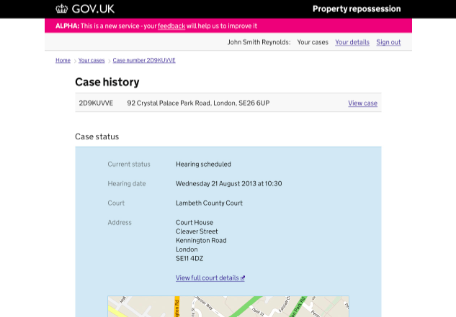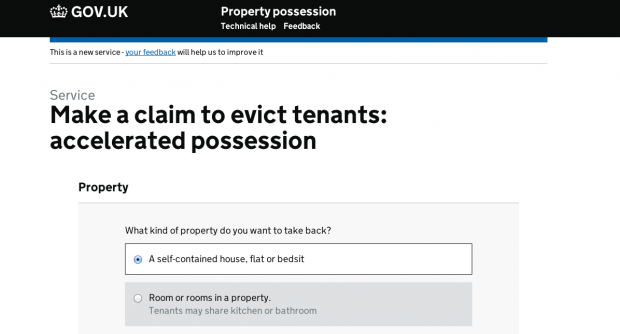Back in August Civil claims accelerated possession service passed its Digital by Default Service Standard assessment. The service has now been live for a few weeks and it’s the perfect moment to take stock. Here Product and Service Manager Eliot Fineberg looks back at how this milestone was reached.
"The first thing I would say is that getting to live is an achievement the team can be proud of. The service was up and running within 10 weeks of the start date, making it much simpler for landlords to claim back their property from tenants who refuse to move.
But it’s also been one heck of a steep learning curve. The last 8 months have probably been the most challenging (read difficult) I’ve had in my career so far. Which is why I thought it’d be useful to talk about what it’s been like for the Civil claims team, as well as the wider Ministry of Justice.
The optimism of the discovery phase (and the dangers of thinking too big)
The service we delivered was not what we started out with. Our original intention had been to replace the entire online system for making different kinds of possession claims.
There are approximately 1.5 million civil claims made every year, of which 239,000 are possession claims. Earlier this year our designer George Sheldrake did some work to map all the different kinds of civil claims.
Our discovery phase dug deeply into the existing possession claims online service (PCOL), focusing on how it was used and by whom. As this online service already exists, the decision to start with transforming it was based mainly on an evaluation of existing functionality.
The team spoke to court staff, legal professionals and helpline experts to get an in-depth picture of how the current service is used and which elements could be improved. This resulted in a really detailed picture of the user and what they need. We worked with all the joyous optimism that often comes with a discovery phase: we wanted to do everything, immediately.
Starting. And having the courage to start again.
In the beginning, we focused on presenting only the questions each user needed rather than having them do the hard work of trawling through a complex form.
We developed a much-simplified user interface and built both paper and html prototypes for user testing. This was our alpha. It focused on just one user need - “as a claimant I want to make a claim I understand”. Having confidently made the prototype we confidently proclaimed that we had completed our alpha.

The next step was to build something that could be used for real. We’d been working closely with Bristol County Court (where court staff were enthusiastic and supportive of what we were doing) so it was a logical next step to build our minimal viable product (MVP) beta around this work. That meant making it possible for people to make an online possession claim if their case could be handled by Bristol County Court.
It was exciting and hugely ambitious. It was also the point that we came across some epic unknown unknowns.
We discovered that:
- the end-to-end process of making claim is much more complex than simply making and issuing that claim
- many claims involve a court hearing and there are 180 courts in England and Wales, some of which have a slightly different way of doing things
- court hearings are supported by a significant amount of business logic and software - and anything we built would have to work with this
- paper is essential to the process - courts rely on paper copies being sent to all parties in any court hearing
- the law around possession claims is extremely complex, which made simplifying the user journey hard to do without changing the law
- it would be a very long time before we could release anything
It was this final point that prompted the most pause for thought. If we had continued making a new PCOL there was no way we could have released something fit for public use within 10 weeks, or even 20. Even though the team was turning out great work, week on week, it was making only a tiny dent in the long list of what remained ‘to do’ in order to make our MVP actually viable.
To put it simply, we had chosen the wrong release strategy.
Our agile way of working is geared around making a small thing then testing and tweaking it in line with what users actually need (rather than spending a lot of time delivering what other people think they need). We needed to get back to the basics of delivering value ‘early and often’.
It was this realisation (and some long and serious talks with HMCTS and the senior management team) that gave us the courage to stop what we were doing. That decision meant that we no longer had to relentlessly pursue something just because we’d spent a lot of time and effort on it. But it was not an easy decision to make.
The pay-off
We quickly spotted the benefits of revising our strategy at an early stage. These included:
- winning the trust and understanding of HMCTS and wider MoJ by giving them a good example of what we can deliver, how quickly we can do it, and how easily we can react to feedback
- gaining a far better understanding of our users and what they want (and where this sits in the wider context of how the MoJ interact with the public)
- getting an insight into the intricate workings of the courts and what they need to make things operate more smoothly
- negotiating internal pressures by delivering on promises quickly and not compromising on quality
Pursuing this new direction has made it possible to create a high quality service that was available to the public within 10 weeks. We’ve now got a fully live accelerated possession service that is easy for people to use, even if they don’t have specialist legal knowledge.

The exemplar as a launch pad
Ultimately, we’ve created a service that we can build on. We’ve focused on using plain English, and made it possible to track everything so as to create truly data driven design. We have shown, not told, interested parties that a new way of designing and delivering that can work.
We are now looking at how the work we have done for Civil claims, along with many of the other products that MoJ Digital are building, can be looped together as loosely coupled components.
Our plan is to build services as API’s, get everything talking to each other in open ways and consider how our products can be re-used and re-architected and continually evolved to serve more and more user needs.
In short - by releasing early we have created sufficient space and confidence to develop better, simpler, more useful things. There’ll be many more good things to come.’
You can follow Eliot on Twitter or check out the MoJ Digital feed for more about the digital transformation of justice services.
Leave a comment